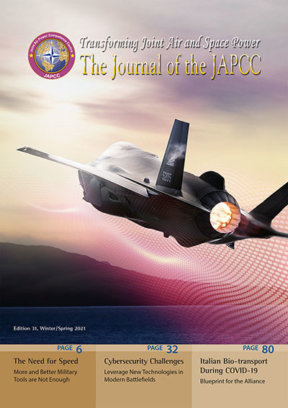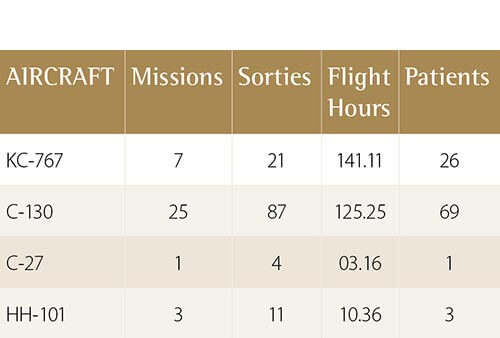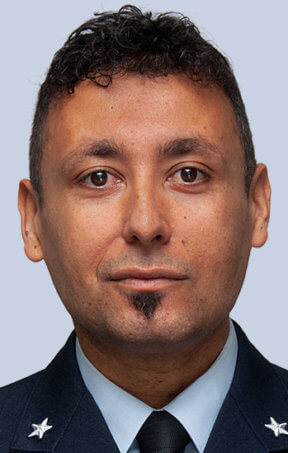Introduction
The Italian Air Force (ITAF) contributes to the Ministry of Defence Coronavirus DISEASE 2019 (COVID-19) pandemic plan of action with various capabilities and structures. A key example of this is the implementation of the Bio-containment team of the Pratica di Mare main infirmary, composed of doctors and nurses specialized in air transport of infectious patients. This is a unique capability of the ITAF and fundamentally important in this emergency scenario, being ideal for quickly and safely transferring infectious patients from one hospital to another. In providing this service, it gives remarkable support to the treatment centres in northern Italy, one of the areas most affected by the pandemic. The ITAF’s experience with Bio-transport, coupled with the lessons learned from the COVID-19 pandemic, highlight the NATO Alliance’s need for this capability and provides key lessons for the future.
Biological Challenges
Viruses, bacteria and fungi are studied because they represent a critical issue in the multinational collective defence system. When considering Bio-containment, one must regard every single bacterium or virus as having an operational potency that is superior to the best weapon system. The presence of just a few cases of an illness that could be transmitted by air, represents a dangerous threat to all the servants in operations.
Any outbreak has a great impact on operational sustainability for the following reasons:
- Limits the manoeuvrability of the forces in the field;
- Imposes a withdrawal in the territory, which results in a lowering of the operating effectiveness;
- Requires substantial healthcare resources;
- Could hinder the tactical response capability of the Role 2-Plus1;
- All individuals become potential carriers of the contamination.
Known bacteria and viruses are always present in the environment and the potential exists for a myriad of undiscovered contagions, hibernating in the glaciers of the poles, to be released for which people have no immune defences, nor the possibility of creating a vaccine. This could be likened to fighting asymmetric warfare where the actors move quickly all over the world without distinguishing borders or combatant status. They could hit and disappear randomly and without warning, act on a large scale, and no intelligence service can determine if they have been defeated or when they may return.
No single organization is able to deal with an epidemic on a national scale, since it requires health resources at a national level that have never been structured or designed to face a moment of crisis of such magnitude. Each nation manages to deal with chemical and geological disasters, but the biological element presents a critical challenge that could deplete or collapse the resources of a nation. The biological aspect has several consequences: it is a moment of social disintegration, it is an economic brake, it has a devastating psychological impact, and it can drain all health resources. However, biohazards must be analysed according to a multi-phase, multi-purpose principle that begins with the strategic approach and ends with the tactical. It is much more complex because of what could happen if a NATO member, or an area that is of strategic interest to NATO, was attacked by an international actor during or after a serious crisis. There have been examples of attacks of this nature in areas where the country’s opposition leader was poisoned. This, in turn, caused the national emergency services to respond in a multi-faceted nature. The impact on national security is not a remote hypothesis, it is a concrete reality. Today the great pandemic of the COVID-19 is a legitimate worldwide threat, but people should consider a context in which numerous biological threats could take place. Any notion that this type of scenario would be best managed by nations turning inward and acting only at a national level not only confirms what NATO foresaw in the late 1990s, but is immediately dispelled by the inefficacy of the national responses seen to date regarding COVID-19.
Implementation During the Pandemic
Transport aircraft that are normally used for different types of missions – from search and rescue to support for special operations–become real ’flying ambulances’ when emergencies take place. They are capable of transporting patients in Bio-containment mode through special isolated stretchers called Aircraft Transit Isolators (ATI), as well as assisting patients with respirators during the flight.
The ITAF developed this particular transport capacity several years ago, when it first realized that this specialisation would fill existing gaps in capabilities, and the history proved it right when it became crucial during the difficulty times of the Ebola or the Severe Acute Respiratory Syndrome (SARS).
The first experiment occurred in 2005, while the first operational flight followed on 24 January 2006 when a C-130J aircraft rescued a patient suffering from a severe form of pulmonary tuberculosis resistant to any drug treatment.2 It is a valuable activity that the ITAF has carried out for over fifteen years, and made them a leader in the field of air transport in Bio-containment.3 However, the current demand for patient transport has significantly increased. For this reason, the ‘Reparto Sperimentale Volo’ (RSV) which is one of the three departments within the Experimental Flight Centre, was involved in increasing both the transport capacity of patients in isolation and the number of medical support teams.
By using the Technical-Operational Certification (CTO), the RSV launched a series of studies, research and experimentation activities aimed at producing the necessary documentation to expand the ability to transport different types of stretchers, both on transport aircraft for long-range flights, and on helicopters for short-distance connection. Thanks to the teamwork between pilots, engineers and experimental mechanics, the RSV released the CTOs in less than two weeks in the simplest cases, while in more technically complex situations, they physically built and adapted electro-mechanical pieces to allow the use of the different stretchers on multiple types of aircraft. This considerably enhanced the bio-containment capabilities of the KC-767A, C-27J, C-130J and numerous helicopters, such as the HH-101A, HH-139A and HH-212.
During air transport, the patient travels inside special Aircraft Transit Isolator System (ATI). In general, an ATI consists of a frame (rigid or semi-rigid), a Polyvinyl Chloride (PVC) casing (so-called envelope) that allows observation and treatment of the patient in isolation, a battery-powered motor that allows maintenance of negative pressure inside and High Efficiency Particulate Air (HEPA) filters that prevent the entry of potentially infected micro particles at the inlet and outlet, guaranteeing the safety of healthcare workers who assist the patient.
The team consists of a Team Leader, at least two medical officers and six non-commissioned officers. The Team Leader is a senior medical officer who has the task of coordinating the mission, managing relations with the civil entities involved, and supervising the progress of operations. The medical officers are an anaesthetist and an infectious-disease specialist who are responsible for the health management of the patient, while the six non-commissioned officers assist the patient and carry out the transport procedures.
Air transport in Bio-containment is a military capability, available for civil use and purposes (dual-use). Numerous civil and military organizations, both national and international, have requested specific training activities from the Air Force on the management and transport of highly infectious patients to acquire the skills and the techniques needed to manage transport situations in risky bio-containment environments.
Beginning in 2013, the Bio-containment team participated in the NATO exercises: VIGOROUS WARRIOR 2013, 2017, 2019 and TOXIC TRIP 2019, incorporating NATO’s Allied Command Transformation’s (ACT) intent to overcome several limits to interoperability through the process of technological and capability innovation to operate in multinational contexts.4 The experience gained during the Ebola emergency, participation in NATO’s health exercises and exchange activities with foreign nations (The Netherlands and United Kingdom) led the ITAF to identify a new mission and vision for the use of the structure of Bio-containment in the operational context of Global Bio-security. Everything hinges on the operational concept that pandemics are a global problem where if a ’Readiness Action Plan’ or a ’Bio-responsiveness High Readiness Multinational Task Force’ type construct fails to adequately address the risks, then Global Bio-security problems may arise. A large-scale epidemic could shake the foundation of international health security by creating areas of vulnerability which could interfere with the sustainability of NATO’s defensive framework, in case we should face a scenario consisting of multiple massive proportion emergencies simultaneously. Moreover, one must consider the importance of assistance to allied nations troops affected by infectious diseases while deployed in areas where there is no health care facility available capable of providing treatments with the same level of accuracy. For this reason, the ITAF has equipped its air transport systems with biological isolation capability, that allows them to operate with the maximum safety and protection for flight crews.
Lessons Learned for the Entire Alliance
COVID-19 is a biological threat that affects the Euro-Atlantic zone and their areas of strategic influence with the unconventional characteristics of asymmetric warfare. This highlights the need to continuously remodel the operational planning process by calibrating it in relation to the affected areas, the number of people to be evacuated, the reconfiguration of field hospitals and the need to guarantee the sustainability of supplies.
The key factor is time, which allows one to act by transporting affected patients promptly to the reference care centres before the disease progresses. It is essential to create a strategy to respond to a pandemic based on prevention, identification of the threat, its geolocation, isolation and evacuation of patients. One of the primary mechanisms for responding to civil emergencies in the Euro-Atlantic area is air support. In addition to the purely logistical aspects, nations should keep in mind that NATO forces may need to be redeployed using air assets to safer areas for health reasons whenever the need arises.
Service members that continue prosecuting the mission must be given the certainty that, in case of contamination, they will be assisted and treated promptly. For this reason, Bio-containment shall be considered as a fundamental pillar within the Strategic Airlift International Solution (SALIS) and the Biological Strategic Airlift Capability (BSAC).5 It will have to be considered a reality that should have its tactical role within NATO’s Air Mobility operations. There is a need to create NATO doctrine on air operations, specifically in Bio-containment where the capacity of the Alliance forces can have, through sharing of resources, a joint multinational force capable of operating in an intercontinental context. The maximum speed of effectiveness in transferring infected patients can definitely help to reduce the area and spread of infection. This is an ambitious goal, a new operational capability for NATO, which will have to be shared within the Alliance and its partners to train, practice and operate effectively together, carrying out assigned missions and tasks.
There are two types of fundamental factors in interoperability between nations: core and enhancement. They consist of promoting a series of elements which are crucial for the success of each mission. These include the terminology, the doctrine of Bio-containment on a multinational basis, the ability to identify a multinational mission and vision on common objectives with allied forces, and to reshape industry to produce ATIs that have compatible standards, so that any aircraft in the NATO transport fleet could use them.
A Look into the Future
There is always an opportunity for improvement and that is particularly true in those areas that are high technology and rapidly changing. The 2020 pandemic emphasised that the Alliance should definitely consider developing Bio-transport capability as it has been crucial in managing the pandemic. The ITAF has accrued fifteen years of experience in this field and was ready to face the imminent situation, being able to carry back to the home nation several personnel from remote areas. The ITAF, among others with this capability, was able to further validate its Bio-transport, gaining valuable teachings such as the need to continuously reshape the operational planning process by adapting it with regard to the affected areas, the number of people to be evacuated, the reorganization of field hospitals and the necessity to ensure the sustainability of supplies. For all the reasons highlighted above, NATO should take into consideration to add this doctrine to the broad arsenal already owned. As much as one might hope that the COVID-19 pandemic will be the last pandemic humans will endure, pragmatism demands that member nations ready the Alliance for the next occurrence by further developing Bio-transport and implementing mutual exercises. Preparation, including development of tactics, techniques and procedures is a far more effective strategy than reaction.













